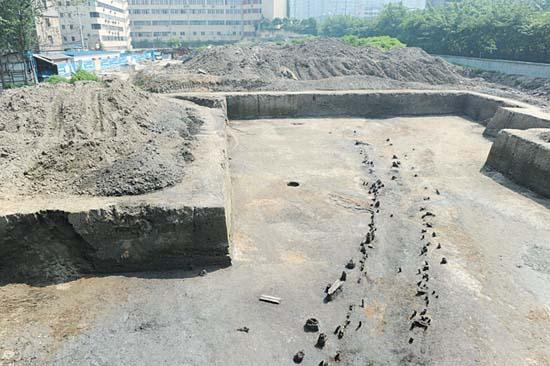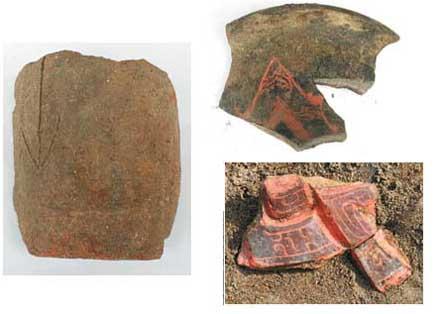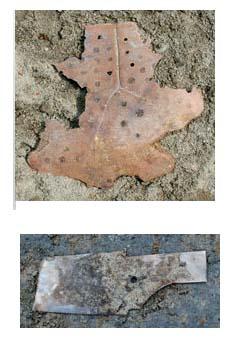New Discoveries of Shang-Zhou to Sui-Tang Dynasties at Shierqiao site in Xinyicun location, Chengdu
Chinese Institute of Archaeology
Source - http://www.kaogu.cn/en/detail.asp?ProductID=3501
The Shierqiao site at Xinyicun area is located in the south of Shierqiao Road, Qingyang District, Chengdu, which is surrounded by a cultural park in the south, the Xijiao River in the east and the Shierqiao archaeological site in approximately 100 meters in the west. In 1995, in order to fit the needs of basic constructions, the Chengdu Institute of Archaeology and cultural relics conducted exploration and excavation in the Xinyicun area. The total area of excavation is 396 square meters. In December 2010, the Chengdu Institute of Archaeology further excavated the neighboring area in the south of the excavated area in 1995. The Institute divided the selected area into grids of seventeen 10mX10m square pits and four 5mX10m square pits. The area totaled 1900 square meters.

The archaeological site is composed of twelve layers of cultural strata. The main stratum consists of cultural relics from the Baodun period to the Sui-Tang Dynasties. The stratum of Shang-Zhou Dynasties is richly filled with three groups of cultural relics. The first group is composed of relics from the Baodun culture. It contains pottery objects made of clays with black surface. Shapes include vessels with long neck and flared opening and Zun-type containers. Incised lines and wave patterns form the key decorative motifs.
The second group of artifacts is dated to the Shierqiao Culture period. Remains include one wooden structure, seven ash pits, three pits and two ditches. The wooden structure is arched shape in plane. It extends from the southwest direction to the northeast. The remaining length is approximately 31 meters while the width is 5.2 meters at its widest portion. The structure is supported by wooden and bamboo columns. The rooftop had the trace of burnt and collapsed. The function of the structure remains unknown. A section of a beam supporting the foundation of the structure is revealed during the excavation. This group of artifacts from the Shierqiao Culture period contains mainly pottery objects. Bronze, jade and objects made of stone and bone are found in a smaller quantity. The pottery objects can be divided into two categories, one made of clays containing sand and the other made of clays with black surface. The clay containing sand can be further classified by color. Brownish black and brownish red clays form the majority while a small quantity of brownish grey clays are recorded. The pottery objects vary in shape. They include cups with pointed base, small plates with pointed base, vessels with contracted mouth and wide shoulder, vessels with flat base, vessels with flared opening, vessels with dish-like opening, basins and vessels with round base. Fragments of painted and lacquered pottery are scattered. This is the first discovery of such artifacts in the stratum of sediments of Shang-Zhou Dynasties. Bronze objects recovered from the site are mainly smaller objects which include arrowheads, blades, chisels and copper components. Various types of decorative jade are identified which include ge dagger, huang pendant, ring, bead and tube. Stone objects range from cong tube, bi disk, jue ear-ring, axe, adz and knife. Bone objects include arrowheads, chisels and drills. A significant number of oracle bones, mainly made of tortoise plastron, are recovered.

The third group of artifacts represents art and craft from the Xinyicun period. The majority of objects are pottery made of brownish grey clays containing sand. They include gui-shaped vessels, cauldrons, basins, small plates with pointed base and urn-shaped vessels. The key finding in this stratum is the discovery of typical Chu-style li tripods which are believed to be produced in the Spring and Autumn Period or earlier. This result suggests that the formation of the stratum of sediments of the Shang-Zhou Dynasties lasts until the Spring and Autumn Period.
The remains from the Warring States Period contain one tomb pit, three sets of urn coffins, five ash-pits, one ditch and one pottery well. The tomb pit is measured 2.5 meters in length, 1.2 meters in width and 0.12 meter in depth. Unlike most other tombs, human bones and burial tools are not found. The burial objects found in the tomb pit are round-based dou vessel, bowls and cauldrons. The pottery well provides a wealth of artifacts. The archaeological team recovered twenty-three pottery pots, twelve pottery cauldrons, one five-zhu coin and one half-tael coin. Artifacts from the Warring States Period are mainly pottery objects made of brownish black and brownish red clay containing sand, followed by small quantity brownish grey clay containing sand and grey clay pottery. The identified shapes include small plates with pointed base, cauldrons, basins, pots, urns, lids and ding-tripods.
Cultural strata of the Qin-Han Dynasties are often disturbed. Apart from the eight pottery wells, only one ash pit, one pit and one ditch can be recovered. The majority of pottery objects are made mainly of brownish black clay containing sand and brownish grey clay, followed by grey clay containing sand. A small amount of pottery objects made of brownish yellow clay containing sand and gray clay are recorded. The shapes of the unearthed pottery objects include cauldrons, bowls, basins, pots, ding-tripods, urns and lids. Apart from pottery vessels, they also found a large quantity of tiles with striated decoration, coins of half-tael, five zhu and daquanwushi.

The Tang-Song Dynasties deposits consist of one house, nine ash pits, two pits, two ditches, four ponds and eight brick wells. The amount of ceramic objects predominates other materials. A small quantity of stonewares are also excavated. The ceramic vessels include bowls, small plates, pots and spittoons. They are mainly produced locally at the imperial kilns in Qingyang. The tools used in producing ceramics include supporting nails and carrier rings. Potteries are found in the shape of basins, bowls and tiles decorated with lotus flower motif. Xinyicun is located within the range of Qingyang imperial kiln site in the Sui-Tang Dynasties. It is likely where the workshops of the Qingyang imperial kilns are located. This excavation provides information that supplements the earlier study of the Qingyang imperial kiln.
The excavation at the Shierqiao site and the Xinyicun site in 1995 did not yield any artifacts from the Baodun period. The current exploration and excavation at the Xinyicun site again is a breakthrough in unveiling the mystery of the Baodun Culture. It provides concrete evidence in the study of the development of the Baodun Culture. The discovery of a classical Chu-style li-tripod in the Spring and Autumn Period stratum is the first of its kind in the Chengdu plain. It is the key evidence suggesting the cultural exchange and interaction between the Chu state and Western Sichuan in the Spring and Autumn Period. Ritual objects such as jade ge dagger, stone cong tube, oracle bones, stone bi disk, painted and lacquered pottery vessels found during the current excavation suggest the special purpose of this site. Its function is likely the same as the Jinsha heritage site, which is worth our further study and exploration. The excavation at the Xinyicun site this year aids the interpretation of the nature of the local culture, the dating of the formation of the culture to a wider time range and the analysis of the purpose of the settlement, which all ultimately refines the archaeological chronological framework of the Chengdu plain in the Eastern Zhou Dynasty. (Translator: Sharon Chan)